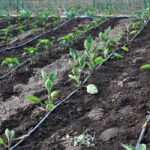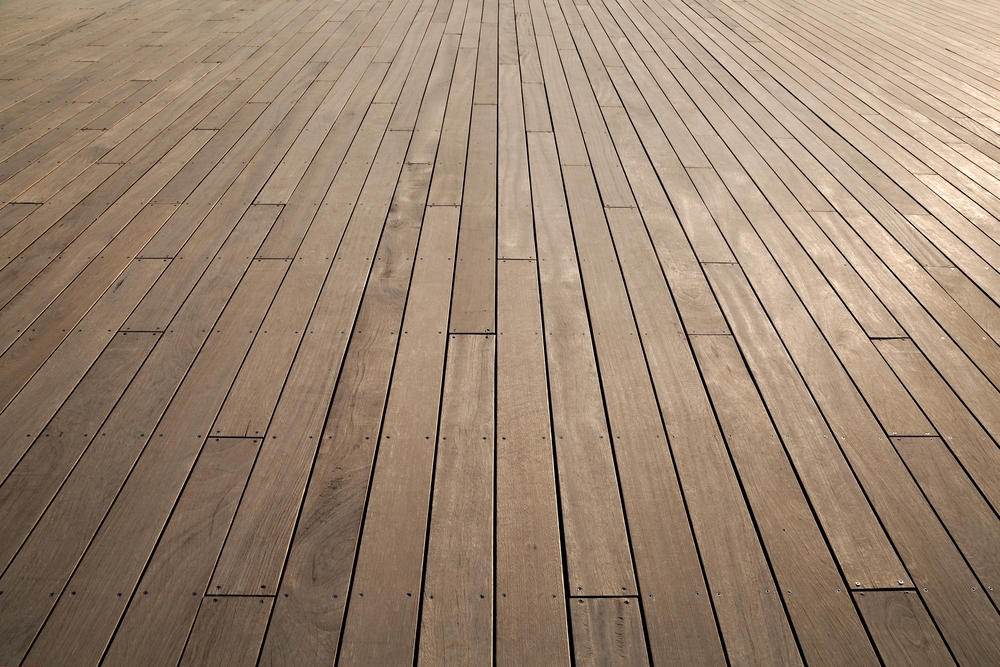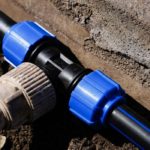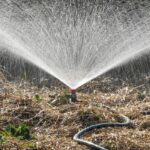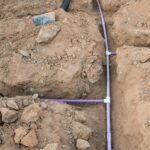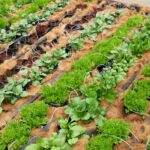Drip irrigation provides a precise application of water when and where plants need it, making it one of the most efficient methods of delivering water to your garden or yard. But installing drip irrigation lines requires special care and proper technique. So, should you bury your drip irrigation lines?
It’s best not to bury drip irrigation lines since the soil’s weight can damage the system. Instead, cover the lines with mulch or run them under raised beds if you don’t want them to be seen. Drip lines also come in a variety of colors; choose one that blends well with the surrounding environment.
Drip irrigation lines are more efficient compared to traditional spray irrigation, where a large volume of water is lost to evaporation. Let’s look at how drip irrigation works, the different types of tubing available, and whether burying a drip line is ever a good idea.
What Is Drip Irrigation Tubing?
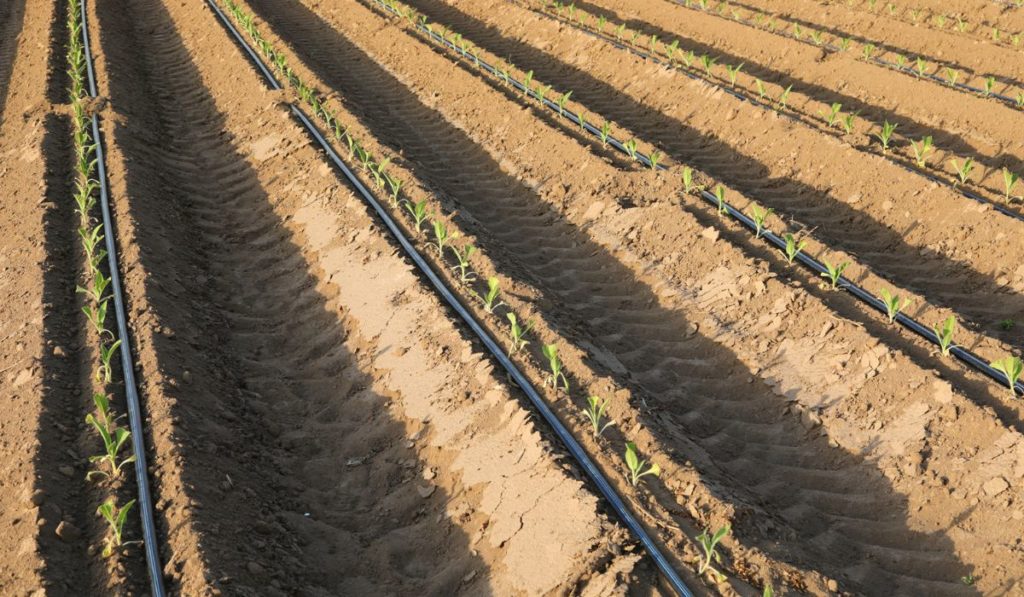
Drip irrigation is a highly efficient method of watering your plants because there’s less evaporation compared to other irrigation methods. The best thing about this method is that it ensures an equal volume of water for all plants. You can scale it up to deliver water to entire fields (see picture above), but you can also run much smaller systems on low pressure lines from a hose, so, you also have options on what scale you want to deploy drip irrigation.
This type of irrigation system keeps the roots moist but not soaked. On average, drip irrigation tubing uses almost 20% less water than a soaker hose and up to 75% less than sprinkler systems.
There’s less water lost to evaporation and overspray as water is delivered directly to the root zone. With this irrigation method, there’s hardly any leaf wetness, which results in healthier plants and quality flowers and produce.
You can also add a timer (on Amazon) to the hose and schedule automatic watering of your plants for the best time of the day.
Why Is Drip Irrigation Popular?
Drip irrigation ensures a low evaporation rate, leading to higher water conservation. This is one of the primary reasons why many people opt for this system. By using drip irrigation, the water only has to cover a short path from the tube to the plant, so there’s minimal run off and waste.
Another great thing about drip irrigation is that it works on low pressure. There’s not much electrical energy needed to power up the water pumps. You can also direct the water flow to the desired plants with the help of emitters for efficient watering.
Should Drip Irrigation Tubing Be Buried?
Although drip irrigation tubing can be buried beneath the soil, it’s better not to do so as the weight of the soil will compress the tubes. This can cut off the water flow and may even cause damage to the system.
There’s also the danger of the system becoming clogged because of the soil. This could considerably reduce the lifespan of the drip irrigation tubes.
Another thing that could damage the drip irrigation tubes are rodents and gophers. These burrowing pests can chew through the tubing. It’s also difficult to locate a leak in underground tubes.
Be sure to regularly check and inspect the drip irrigation lines if you do bury them in the ground to ensure that they’re working properly.
Dig the trench for the irrigation lines, and before burying the system, make sure that it’s pressurized. Installation of an air vent vacuum relief valve (on Amazon) is also recommended in subsurface systems.
Camouflaging Drip Irrigation Lines
Instead of burying the drip irrigation tubing, hiding them with mulch, running them beneath raised beds, or camouflaging them are also excellent alternatives.
If you want to preserve the aesthetics of your garden, you can use one of the following ways to hide your drip irrigation lines:
Use Mulch
Covering the drip irrigation lines with mulch protects them from cracking or melting. This method works in both hot and cold environments. You won’t have to cover the drip irrigation lines too deeply in mulch if you choose their color to match the surroundings.
Two to three inches of mulch is enough to cover the drip lines. This will not just hide the lines effectively, but will also keep the soil hydrated. Do a little research to find out the best type of mulch for your area before covering your drip irrigation lines.
Use Color Camouflage
Color camouflage is a very easy way to hide your drip irrigation lines. These lines come in various colors, and you can choose one that matches the surroundings. Black or brown drip irrigation lines tend to blend well with the dark-colored soil.
Running Beneath Raised Beds
Another excellent way to hide the drip irrigation lines in urban homesteads, as well as backyard farms, is to place them beneath raised beds. Careful consideration should be given to the placement of raised beds while planning your garden.
Be sure to construct them in a way that drip lines run below or through the raised beds. This will ensure that the raised beds receive water without the drip irrigation lines becoming visible.
What Are the Different Types of Tubing?
The wide range of drip irrigation tubes available can make it quite difficult to choose a product that’s perfect for your needs. Whether you want to set up drip irrigation on your farm or your home garden, it’s essential to compare various products before making a choice.
Tubes made from polyethylene are best for drip irrigation. They are durable and will ensure the deficient performance of your irrigation system for a long time.
Let’s look at the different types of tubing to help you find the one that’s right for you:
¼-Inch Soaker Dripline
Commonly used in planter boxes, garden beds, etc. the 1/4-inch soaker dripline (on Amazon) comes with pre-installed emitters. These emitters are evenly spaced along the pipe at 6, 9, or even 12 inches. They are highly flexible and can be folded for convenience.
½-Inch Emitter Tube
This ½-inch tube (on Amazon) is highly suitable for long rows on flat or hilly terrain. They come with pre-installed emitters evenly placed at 9, 12, 18, or 24-inches. These tubes are widely used in vineyards, orchids, etc.
Oval Hose
The oval hose is best for low-pressure irrigation. Also made from durable polyethylene material, the oval hose can be coiled up neatly for convenience.
IPS Tubing
IPS tubing is an extremely strong, flexible, and durable hose. It’s typically used in vineyards to connect grape rows with the underground water tank. However, these tubes aren’t suitable for use at constant pressure.
Soaker Hose vs. Drip Irrigation
Before comparing soaker hoses with drip irrigation, let’s first review what a soaker hose is:
What Is a Soaker Hose?
A soaker hose (on Amazon) has tiny holes along its entire length, from which water can easily trickle through. It looks like a garden hose and is placed on the soil surface to deliver water regularly to your plants.
Typically, soaker hoses are made from a combination of polyethylene plastic and rubber; however, you can also find BPA-free, polyurethane models in the market.
Soaker hoses are easy to hook up and don’t require large sums of investment for an average home garden. They deliver water at ground level, keeping the foliage dry and fungal growth-free.
Pressure regulators are not typically needed with soaker hoses, as you can adjust the water pressure from the tap. They work well with timers and there’s rarely any problem of clogging.
Which Irrigation System Is Better?
Drip irrigation is better than a soaker hose when it comes to large gardens planted in long, straight rows. Their versatility in configuration possibilities makes them an ideal option for gardeners, as it’s not possible to close off sections of a soaker hose.
Drip irrigation systems ensure less evaporation as water is sent directly to the plant roots. Soaker hoses are less precise compared to drip irrigation, and they don’t provide coverage that’s as broad as with drip irrigation.
Although drip irrigation systems require a larger investment due to higher start-up costs, these systems are highly durable and able to perform efficiently for many years.
How Long Can a Drip Line Be?

The length of a drip irrigation line depends on the water pressure and its width. For best results, it’s critical for the tube’s length and width to be in proper proportions. An unequal ratio of width and length will not allow you to reap the expected benefits.
In addition to diameter and length, the water pressure also plays an essential role. However, excessive fittings and pressure can damage the drip irrigation tubes.
Standard Width of a Drip Line
Most people prefer the standard ½-inch wide drip irrigation tubes, but with the different varieties of tubing available, the width changes considerably.
Some people also use a ¼-inch tube, which is popularly known as spaghetti tubing. However, it’s important to note that maintenance of ¼-inch tubing can be quite a hassle.
Standard Length of a Drip Line
The length of your drip line can go up to 2,000 linear feet if you have installed the standard ½-inch wide tube in your garden or farm for drip irrigation purposes. A drip line of this size can easily handle a maximum flow of 4 GPM or 240 GPH.
However, if you’re using a drip irrigation tube that’s ¼-inch wide, then its length must not be more than 19 feet. This size of drip liner can easily handle a maximum flow of 0.5 GPM or 30 GPH.
The best size and length of your drip irrigation line depends on your requirements. It’s best to avoid installing large capacity tubes, as they might be left underutilized. This could also affect the tube’s water pressure.


